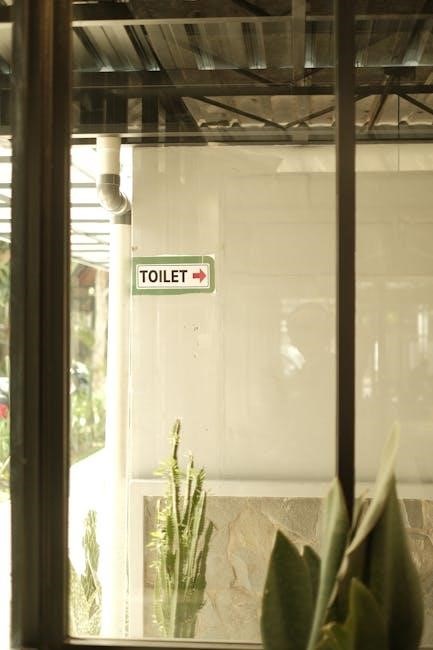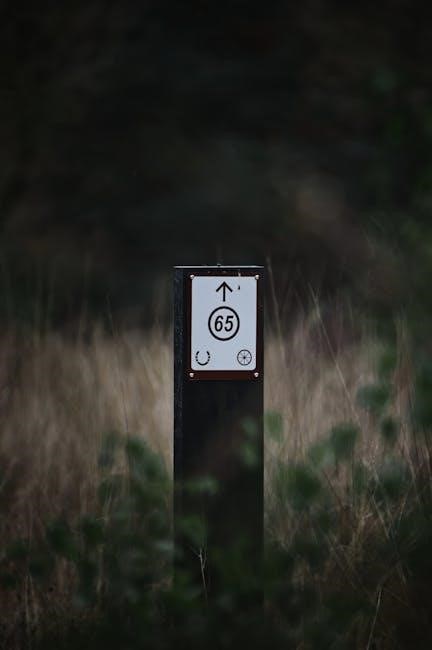Welcome to the Brecks Planting Guide, your trusted resource for mastering bulb and perennial gardening․ Explore expert tips, care instructions, and design ideas to create stunning, thriving gardens․

Spring Planting Guide
Discover the best spring-planted bulbs and perennials for vibrant blooms․ Plant Crocus, Tulips, and Daffodils in fall for spring color, and choose perennials like Daylilies and Peonies for lasting beauty․
Spring-Planted Bulbs
Spring-planted bulbs are perfect for adding vibrant color to your garden․ These bulbs typically include varieties like Gladiolus, Calla Lilies, and Cannas․ Plant them after the last frost in well-draining soil for optimal growth․ Ensure the planting depth is 2-4 times the height of the bulb, and space them 3-6 inches apart․ Water thoroughly after planting and keep the soil moist during the growing season․ Fertilize lightly at planting time and again after flowering to promote healthy blooms․ These bulbs thrive in full sun to partial shade, making them versatile for various garden settings․ With proper care, they will bloom beautifully in mid to late summer, adding a stunning display to your landscape․
Spring Perennials
Spring perennials are a delightful addition to any garden, offering lasting beauty year after year․ Popular choices include Coneflowers, Bee Balm, and Daylilies․ These plants typically bloom in late spring and require minimal maintenance․ Plant them in early spring or fall, ensuring the soil is well-prepared with organic matter․ Most perennials prefer full sun to partial shade and well-draining soil․ Water regularly during the first growing season to establish strong roots․ Deadhead spent blooms to encourage more flowering and divide plants every few years to maintain vigor․ With proper care, spring perennials provide a vibrant display of colors and textures, creating a dynamic and enduring garden landscape․

Fall Planting Guide
Discover the best bulbs and perennials for fall planting, such as tulips, daffodils, and crocus․ Plant in late summer to early fall for vibrant spring blooms․ Optimal soil preparation and proper spacing ensure healthy growth and stunning results․
Fall-Planted Bulbs
Fall-planted bulbs are a cornerstone of seasonal gardening, offering vibrant blooms come spring․ Popular choices like tulips, daffodils, and crocus thrive when planted in late summer to early fall․ These bulbs require a planting depth of 2-3 times their height and spaced 3-6 inches apart․ Ensure well-draining soil and full sun to partial shade for optimal growth․ Alliums and hyacinths add unique textures and fragrances, while grape hyacinths naturalize easily․ Plant bulbs after the first frost to prevent premature sprouting․ Water thoroughly and apply a layer of mulch for insulation․ Proper care ensures a spectacular display of color in early spring, creating a beautiful foundation for your garden’s renewal․ Fall-planted bulbs are a simple yet impactful way to embrace the changing seasons․
Fall Perennials
Fall perennials are perfect for adding late-season color and texture to your garden․ Plants like asters, sedum, and ornamental grasses thrive when planted in fall, as the cooler temperatures promote healthy root development․ These perennials are ideal for creating vibrant borders or filling gaps in existing beds․ Asters and chrysanthemums provide bursts of color, while sedum offers striking structural interest․ Plant them in well-draining soil with full sun to partial shade, depending on the variety․ Fall perennials are also great for attracting pollinators during their final blooms of the season․ By planting in fall, you ensure your garden remains dynamic and beautiful well into the colder months․ Proper soil preparation and mulching will help these perennials establish themselves for years of enjoyment․ Fall perennials are a smart choice for extending your garden’s beauty․

General Planting Tips
Ensure proper soil preparation, adequate spacing, and suitable planting depths for optimal growth․ Water thoroughly after planting and maintain consistent moisture during the first growing season for strong establishment․

Planting Depth and Spacing
Planting depth varies by plant type, with bulbs typically planted 2-3 times deeper than their height․ For perennials, place the crown at soil level․ Spacing depends on mature size—plant closer for immediate impact, farther for gradual growth․ Proper spacing prevents overcrowding, promoting healthy air circulation․ Dig holes or trenches for multiple plants, ensuring roots are spread and soil is firmly packed․ Water thoroughly after planting to settle the soil․ Adjust depth and spacing based on specific plant requirements for optimal blooms and foliage․ Always refer to the Brecks Planting Guide for detailed instructions tailored to your plants․
Soil Preparation
Proper soil preparation is essential for healthy plant growth․ Start by loosening the soil to a depth of 12-18 inches to improve drainage and root development․ Mix in organic matter like compost or well-rotted manure to enhance fertility and structure․ For bulbs, ensure the soil is well-draining to prevent rot․ Test your soil pH and amend if necessary, as most bulbs and perennials prefer slightly acidic to neutral soil (pH 6․0–7․0)․ Remove debris and weeds to create a clean planting area․ Incorporate a balanced fertilizer at planting time, following package instructions․ Well-prepared soil promotes robust growth, vibrant blooms, and long-lasting performance in your garden․ Refer to the Brecks Planting Guide for soil-specific advice tailored to your plants․

Bulb Care and Maintenance
Proper care ensures vibrant blooms and healthy growth․ Water bulbs when soil is dry, fertilize during growth, and allow foliage to yellow naturally after blooming for energy storage․
How to Handle Bulbs Upon Arrival
Upon arrival, inspect bulbs for any signs of damage or mold․ If planting immediately, gently remove packaging and soak bulbs in water for 2-4 hours․ If delayed, store in a cool, dry place (40-50°F) in original packaging․ Avoid freezing or high humidity․ Plant as soon as possible to prevent drying out․ For bare-root plants, keep roots moist by wrapping in damp paper or cloth․ Handle bulbs carefully to avoid bruising or breaking, as this can reduce flowering potential․ Proper handling ensures healthy growth and vibrant blooms․
Storing Bulbs
Store bulbs in a cool, dry, well-ventilated area to maintain their health until planting․ Ideal temperatures range between 40-50°F (5-10°C)․ Avoid freezing or high humidity, as this can cause rot․ Place bulbs in paper bags or breathable containers, ensuring air circulation․ Do not store in plastic bags, as moisture can accumulate․ For fall-planted bulbs, store for 3-4 weeks at 50-60°F (10-15°C) before planting to break dormancy․ Spring-planted bulbs can be stored for up to 8 weeks․ Check periodically for mold or soft spots and remove affected bulbs․ Proper storage ensures bulbs remain firm and ready for planting, promoting healthy growth and blooming․
Fertilizing Bulbs
Fertilizing bulbs is essential for promoting healthy growth and vibrant blooms․ Apply a balanced, slow-release fertilizer (e․g․, 10-10-10) at planting time, following package instructions․ For spring-planted bulbs, fertilize lightly when shoots emerge and again after blooming․ Avoid over-fertilizing, as this can lead to excessive foliage and fewer flowers․ For fall-planted bulbs, apply fertilizer at planting time and again in early spring when growth begins․ Use a low-nitrogen fertilizer (e․g․, 5-10-10) to encourage blooming rather than foliage growth․ Water thoroughly after fertilizing to help nutrients reach the roots․ Proper fertilization ensures bulbs have the nutrients needed for robust growth and blooming success․

Garden Design and Planning
Transform your outdoor space with expert garden design tips from Brecks․ Plan by bloom time, choose plants by size, and enhance beauty through thoughtful layout and personalized selections․
Planning by Bloom Time
Plan your garden by bloom time to create a vibrant display of flowers throughout the growing season․ Brecks planting guide helps you schedule plantings so blooms stagger across spring, summer, and fall․ Early spring bulbs, like crocus and snowdrops, burst forth first, followed by daffodils and tulips․ Summer perennials, such as daylilies and coneflowers, take center stage, while fall bloomers like asters and sedum finish the season․ Use this approach to ensure constant color and interest․ View Brecks bloom time guide to select plants that align with your desired timeline․ This method also simplifies maintenance, as plants with similar care needs bloom together․ Achieve a dynamic, ever-changing garden by strategically planning bloom times․
Choosing Plants by Size and Height
When designing your garden, selecting plants by size and height ensures a balanced and visually appealing layout․ Brecks planting guide categorizes plants into tall, medium, and short varieties, helping you create layered gardens․ Tall plants, like peonies or delphiniums, serve as eye-catching backdrops, while medium-sized perennials, such as coneflowers or daylilies, add texture to the middle layer․ Short plants, like creeping phlox or dwarf iris, are perfect for borders or ground cover․ This approach prevents overcrowding and ensures sunlight reaches all plants․ Use Brecks guide to match plant heights with your garden’s needs, creating a harmonious and structured landscape that thrives throughout the seasons․ Proper sizing enhances beauty and functionality, making your garden a true showpiece․

Additional Gardening Tips
Enhance your garden’s beauty and longevity with expert tips from Brecks․ Discover the best bulbs for naturalizing, learn tips for buying bulbs, and explore creative ways to use bulbs in your landscape for stunning results․
Best Bulbs for Naturalizing

Naturalizing bulbs are ideal for creating low-maintenance, spreading displays in your garden․ Daffodils, crocus, and grape hyacinths are top choices, as they multiply over time and thrive in various conditions․ Snowdrops and snow crocus are excellent for early spring blooms and naturalize effortlessly․ Plant them in well-draining soil at the recommended depth, and allow foliage to fade naturally after blooming to ensure energy storage for next year’s flowers․ These bulbs are perfect for meadows, lawns, or woodland gardens, bringing vibrant color and life to your landscape year after year․ Follow Brecks’ planting guide for specific tips on naturalizing bulbs to achieve stunning, self-sustaining displays․
Tips for Buying Bulbs
When purchasing bulbs, focus on quality and suitability for your garden․ Choose firm, disease-free bulbs with no signs of mold or decay․ Larger bulbs typically produce better blooms, so opt for high-quality options․ Consider the specific growing conditions of your garden, such as sunlight, soil type, and drainage, to select bulbs that thrive in those environments․ Purchase bulbs during their peak availability—spring for summer bloomers and fall for spring bloomers․ Always follow Brecks’ planting guide for care instructions tailored to your bulbs․ By selecting the right varieties and following proper planting techniques, you’ll enjoy vibrant, long-lasting displays in your garden․
How to Use Bulbs in Your Landscape
Bulbs are versatile and can enhance any landscape with their vibrant blooms and unique textures․ Use spring-planted bulbs like lilies or dahlias to add summer color to borders or containers․ Fall-planted bulbs, such as tulips or daffodils, create stunning spring displays and naturalize over time․ Layer bulbs in flower beds to ensure year-round interest, with early bloomers like crocus emerging before later varieties․ Incorporate bulbs into wildflower gardens or meadows for a natural look․ They also thrive under trees or in rock gardens, where their low-maintenance growth excels․ Consider using bulbs in cut flower arrangements by planting varieties like hyacinths or alliums specifically for indoor blooms․ By strategically placing bulbs, you can add dynamic beauty and texture to every corner of your garden․
Care Guides for Specific Plants
Discover expert advice for nurturing popular garden favorites like roses and lilies․ Learn soil, watering, and sunlight needs to ensure vibrant blooms and healthy growth․
Rose Planting and Care Guide
Roses are a timeless favorite, offering breathtaking beauty and fragrance․ For optimal growth, plant roses in a sunny location with well-draining soil․ Dig a hole twice as wide and as deep as the plant’s root system․ Gently place the rose, spreading roots evenly, and backfill with soil mixed with compost․ Water thoroughly and maintain consistent moisture, but avoid overwatering to prevent root rot․ Feed roses monthly with a balanced fertilizer during the growing season․ Deadhead spent blooms to encourage repeat flowering․ Prune in late winter or early spring to remove dead or damaged branches․ Protect roses from harsh winters by mulching around the base․ With proper care, roses will reward you with vibrant blooms and lush foliage for years to come․
Lily Planting and Care Guide
Lilies are a stunning addition to any garden, offering elegant blooms in a variety of colors․ Plant lily bulbs in the fall or early spring, choosing a location with full sun to partial shade․ Dig a hole 2-3 times the height of the bulb, placing the bulb with the pointed end up․ Space bulbs 6-12 inches apart, depending on the variety․ Water well after planting and keep the soil consistently moist but not waterlogged․ Feed lilies with a low-nitrogen fertilizer in the spring and again after blooming․ Deadhead flowers to direct energy back to the bulb․ Allow foliage to yellow naturally before trimming, as this supports bulb rejuvenation․ Protect lilies from extreme cold with mulch in winter․ With proper care, lilies will bloom beautifully for years․

Troubleshooting Common Issues
Address planting mistakes by ensuring proper depth and spacing․ Check for overwatering or poor drainage, which can cause bulbs to rot․ Pests or disease may require treatment․
Addressing Planting Mistakes
Common planting errors can often be corrected with prompt action․ If bulbs are planted too shallow, replant them at the recommended depth immediately․ Overcrowded bulbs can be thinned to improve airflow and light penetration․ If spacing is incorrect, gently relocate plants to their proper positions․ Overwatering can lead to rot, so ensure proper drainage and reduce watering frequency․ Pests or diseases may require treatment with organic or chemical solutions․ Monitor plants closely for signs of stress or damage․ Addressing these issues early prevents long-term harm and ensures healthy growth․ Proper care and attention can often salvage plants affected by initial mistakes․ Always refer to specific planting guides for detailed solutions․
